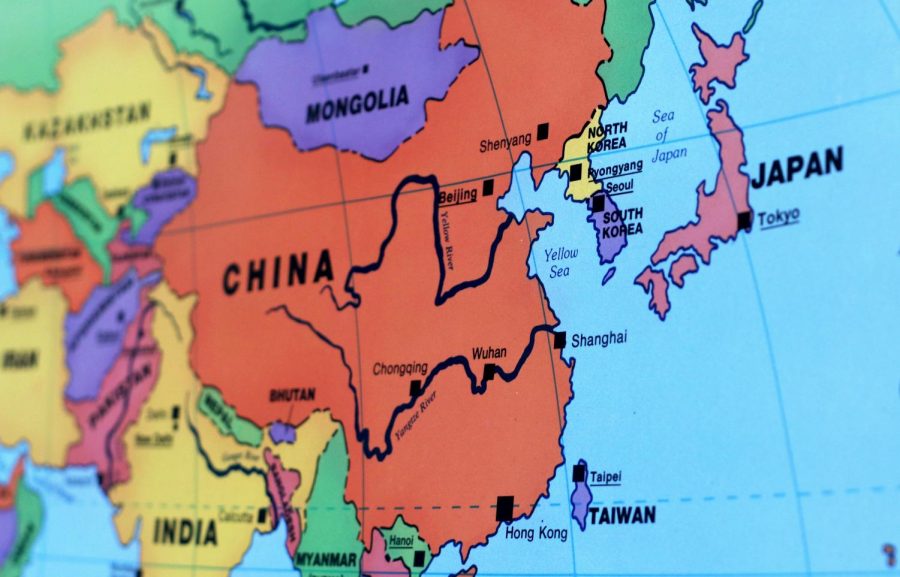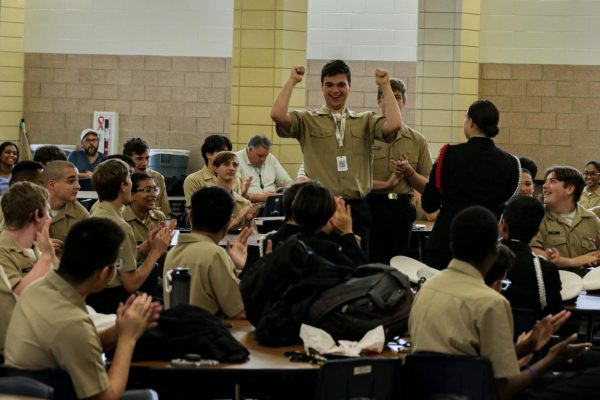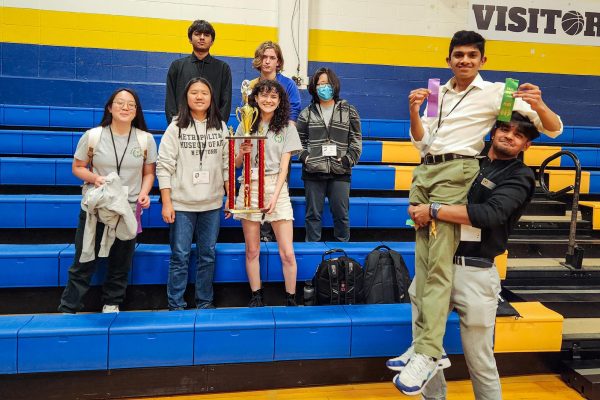Analysis: Experts weigh in on recent U.S.-China conflicts, China preparing to reclaim Taiwan
Taiwan is now Berlin in the new Cold War
Photo by Sarosh Ismail
The People’s Republic of China (PRC) is the country itself whereas the Chinese Communist Party (CCP) is the political party in control of China. The Republic of China (ROC) is known as the island of Taiwan; however, Taiwan’s status is split among those who believe they are the true China and want eventual reunification and those that believe Taiwan is a sovereign state and no longer part of China.
As average high school students, foreign affairs are the farthest thing from anyone’s mind; however, foreign affairs have been brought to mainstream news over the past few weeks with important information everyone should know. Here’s what is happening with China and how it will affect the world:
Since January, China has increased military activity and rhetorical aggression surrounding Taiwan, signaling to many experts that China plans to move up its timeline of reclaiming Taiwan — potentially with force. Tensions have been rising for years with China developing into a global superpower, but COVID-19 has accelerated the conflict and given China the position it needs to make a move on Taiwan: the question is when and how the world will respond.
A brief history of conflict
Following the Chinese Civil War (1927-1949), Chiang Kai-shek, the leader of China at the time, fled to Taiwan as Communist strategist Mao Zedong took control of the mainland and ushered in the authoritarian rule in China we know today. Mao initiated the Chinese Cultural Revolution (1966-1976) and established himself as the supreme political leader, initiating a brutal movement that opposed traditional methods of teaching that were “counterrevolutionary” to the socialist transformation.
The United States initially recognized Taiwan’s government as legitimate and the People’s Republic of China as illegitimate, leaving the world under a “Two China” policy. This changed in 1972 when President Richard Nixon met with Mao in Beijing to witness the “shining beacon” China appeared to be and agreed to the “One China” policy in that the U.S. would only recognize the People’s Republic of China. While the world has a complicated relationship regarding Taiwan’s status, China still sees Taiwan as a renegade province and wants to reunite Taiwan with mainland China before 2049.
America cut relations with Taiwan in 1979 to pass the Taiwan Relations Act, which said that the U.S. would have the capability to aid Taiwan if it was taken through anything other than peaceful means, but never outright said it would come to Taiwan’s aid. This left the U.S. in a temporary position of ambiguity that maintained the “One China” policy and protected Taiwan, but China’s recent aggressive actions have shown that America’s ambiguity will not be enough anymore.
Many Chinese and Taiwanese Hebron students, including senior Jocelyn Chu, are seeing this conflict play out in their own home lives and families with a split in generational beliefs.
“I know that it’s caused many rifts in families due to the ideological differences of the older and younger generations,” Chu said. “Generally, the younger generation is more adamant on going to war with China if push comes to shove, and they believe they can win with America’s help, but the older generation would like to avoid that and believe they would not be able to win.”
Recent events and what they mean
Since President Joe Biden was sworn into office Jan. 20, China has amped up its military aggression by consistently flying and increasing the number of fighter jets and nuclear-capable bombers into Taiwan’s Southwestern airspace. Following the first intrusion on Jan. 23, the U.S. sent the USS John McCain warship to sail through the Taiwan Strait, which separates Taiwan and China, while assuring that the Biden administration is “rock solid” in its support to help Taiwan defend itself.
Prior to the March 18-19 U.S.-China talks in Alaska, which were an unusually tense series of closed and open meetings meant to discuss a variety of issues between the countries, the U.S. sanctioned and aggravated 24 Chinese and Hong Kong officials linked to China’s attacks on democracy in Hong Kong. Economic sanctions are trade withdrawal tactics, such as travel bans, asset freezes and trade restrictions, meant to be a low-cost form of intervention or warning to the country in question.
Following the talks, the U.S. and its allies announced sanctions on China over the genocide of Uyghur Muslims and forced labor camps in Xinjiang Province. Since 2017, China has detained over 1.8 million Muslims in “re-education” camps linked to reports of forced labor, human rights abuses and even forced sterilization. The Chinese government has repeatedly denied these allegations despite substantial evidence, and most governments have elected to ignore these human rights violations to stay on good terms with China.
“At an absolute minimum, it appears to be a human rights crisis that requires immediate attention from the international community,” Borgen Project journalist Katherine Musgrave said. “There has been a lot of research that [shows] sanctions aren’t effective and that their negative impact on the economy can lead to increases in human rights abuses. We need unrestricted access to Xinjiang, so that independent observers are able to define what immediate next steps are necessary.”
The world can function without forced labor. The world can function without human rights abuses. It’s just a matter of how we get there.
— Katherine Musgrave
On March 12, Biden hosted the first “Quad summit” with Japan, India and Australia — countries that have the financial capability to stand up to China. The summit intends to begin with a COVID-19 vaccine distribution initiative across Southeast Asia, and will eventually move into strengthening cooperation in trade and manufacturing to decrease complete reliance on Chinese manufacturing and technology, many of which, such as Huawei 5G, the U.S. has designated as national security threats.
“We focus on China and the U.S. with Taiwan as the flashpoint, and that’s important, but it’s not just China coming into conflict with the U.S.,” co-founder of market analysis website Epsilon Theory Ben Hunt said. “It’s really China acting as an equal to the U.S., both in terms of forming peace treaties with countries the U.S. doesn’t like and battling countries like India — it’s more than just Taiwan.”
Despite all of the conflicts the U.S. has with China, none affect the world more than semiconductors. Semiconductors are compressed integrated circuits that are an essential component in every electronic device, communication or military system and are vital to world function. Taiwan dominates global production of semiconductors, and if China takes Taiwan, the world could potentially lose access to semiconductor production, essentially crippling the global economy and world function.
The U.S. hosted a summit on April 12 with global tech firms such as Intel and Taiwan Semiconductor Manufacturing Company (TSMC) on the global chip shortage that has been worsened by the pandemic’s impact on production. Intel Corporation, an American company that outsourced manufacturing to China, has recently committed to “reopening” chip production in America in an estimated six to nine months, which is an extremely optimistic timeline that many experts doubt and think Intel is anticipating losing Taiwanese production and ramping up domestic production in preparation.
“It is extremely difficult to go from making some kind of semi-advanced semiconductor to making the most cutting edge semiconductors,” Council on Foreign Relations Research Fellow David Sacks said. “China is pouring hundreds of billions of dollars into [semiconductor production,] and so far has nothing to show for it. You have to go through every generation [of production] to get to the cutting edge, and it remains to be seen whether [Intel] will be able to do that.”
China is not investing in these countries out of altruism. It wants to get something out of it, and what it wants to get out of it is to center trade networks and make other economies reliant on trade with China to ensure countries don’t speak out.
— David Sacks
Belt and Road Initiative
The best way to explain the Belt and Road Initiative (BRI) is the joke “everything is made in China” because it’s true. China is the world’s manufacturing hub, and the hub now wants to become a sphere. BRI is an arrangement between China and the country in question where China will loan the country money and develop infrastructure in exchange for the country’s data and eventual payback of the loans: an innovative idea in theory but carried out in the wrong way. China invests heavily in these countries to become a vital commercial base in their economy, and then China is able to control that country by controlling their funds.
Over 130 countries have officially signed onto BRI, while every other country is unofficially involved in some way. Countries such as Australia have already begun to cancel their Belt and Road agreements with China, but most countries are incapable of losing Chinese funding or they risk falling into inescapable debt. If countries speak out against China, they will lose their funding and collapse, a method China uses to censor those denouncing Chinese actions and to control the global narrative with ease.
“China is able to either implicitly or explicitly exert political pressure on these countries not to challenge China on strategic positions and to not call out Chinese behaviors,” Sacks said. “A lot of these projects are not economically viable, [so] countries are not able to repay the debt, and in some instances, these loans are collateralized so that China can exert pressure on countries or else they can threaten to seize assets.”
Experts agree the best way forward is to try to reduce the reliance countries have economically on China, but that solution takes time to put in motion, which is time we may not have.
A New Cold War
Unofficially or officially, the U.S. has entered a cold war with China. The term “cold war” is defined as a state of political hostility between countries characterized by threats, propaganda and other measures short of open warfare. This is not a cold war in the historical sense of “mutually assured destruction” with the Soviet Union, but this is a technological and data cold war that has the potential to turn hot — that potential will either be triggered by Taiwan or it will stay cold.
“I definitely agree that it’s a cold war now with China,” Hunt said. “Ultimately, it is going to require a decision which is [if] Taiwan is enough to fight over. Unfortunately, it looks like [China] is trying to accelerate the time table [to take Taiwan] when the U.S. is trying to play off the clock.”
Since President Xi Jinping has come to power, the Chinese mentality has evolved. Historically, Chinese leaders focused on domestic development and avoiding conflict with influential countries, ie. the U.S. However, China has been watching the U.S. over the past decade, and has decided that the U.S. is in decline, leading China to take greater risks and expand significantly economically through the Belt and Road Initiative.
“I think one of the lessons Xi Jinping has taken away from his tenure is that he can largely act with impunity, ” Sacks said. “He believes that China is growing stronger, and the U.S. is growing weaker. The question then is what does he do, and that is where I think it becomes dangerous with Taiwan.”
This past Tuesday, Xi Jinping gave a speech at the Asia Annual Conference with the typical propaganda and denial of any wrongdoing, but he added a veiled threat to the U.S. while promoting itself as the new global superpower that will never seek “hegemony” and encouraging countries to “share in the vast opportunities” of the Chinese market. Despite China’s claims of innocence, China is at fault for a vast number of things including covering up the origin of COVID-19, misleading the world on lockdown policies using a singular incorrect study from Neil Ferguson at the Chinese-funded Imperial College and consistently ignoring basic human rights in Xinjiang, Hong Kong, Taiwan and more — but at what point does the U.S. draw the line?
Although this conflict seems like it is thousands of miles away, its impact can be felt in our own hometown. While this is not cause for panic, it is vital that Americans remain well-informed and aware of what is happening in our world.
“The solution is to buy time to try to reduce the reliance countries have economically on China,” Hunt said. “Our Cold War with the Soviet Union went on for the better part of 20 years, so it requires a very long game, and I think that’s how you keep a Cold War cold — you spread it out over a long time, and maintain that it will resolve, so that at the end of 40 years, you’re the winner and not the loser.”

Senior Jacquelyn Burrer is a reporter and this is her first year on staff. She loves drinking coffee, playing the flute, studying history and reading books.














Heather Allen • Aug 20, 2021 at 5:17 PM
Great article!
Robert Warwas • Aug 19, 2021 at 5:57 PM
So, one possible solution is to somehow improve the investment “climate” in developing countries and tie them closer to us. I wish there was a quicker way to solve this.